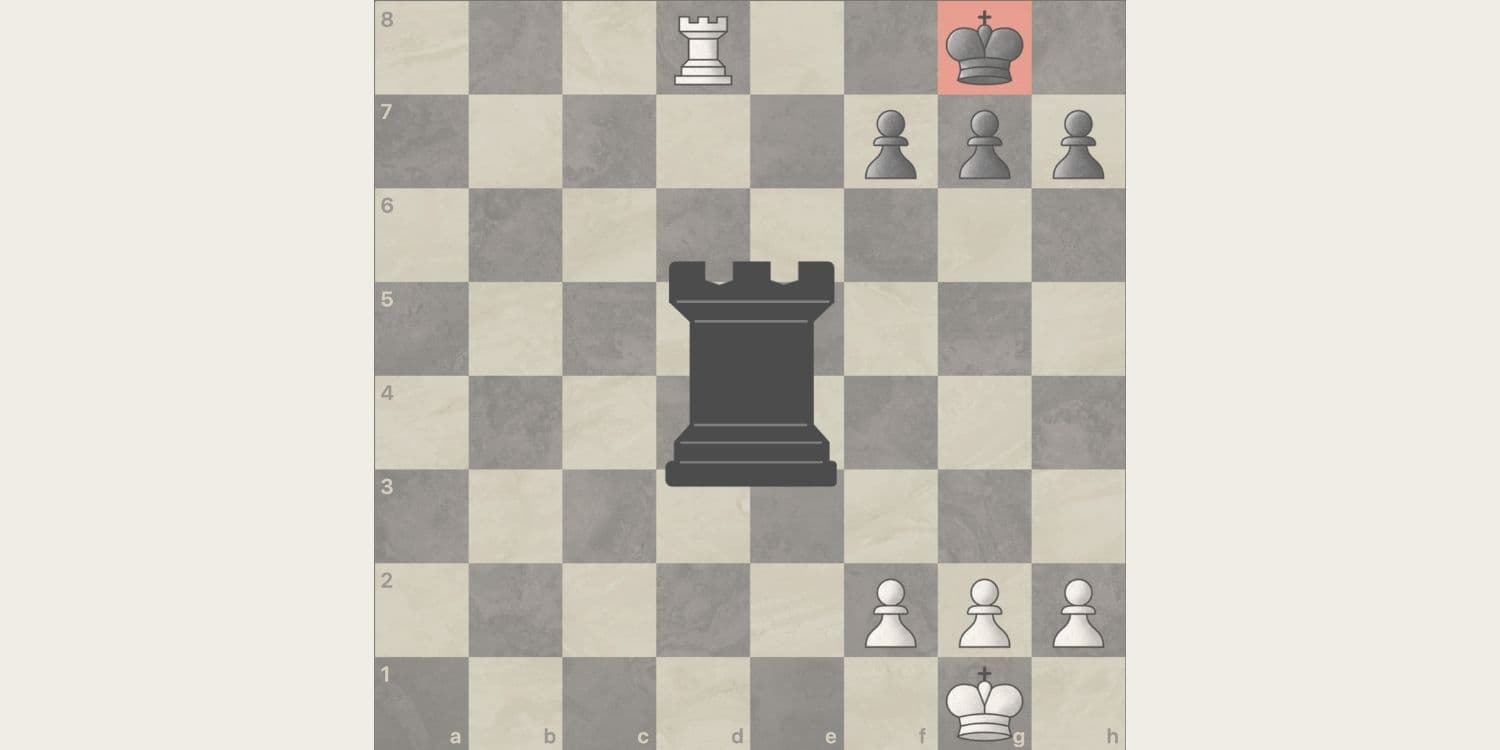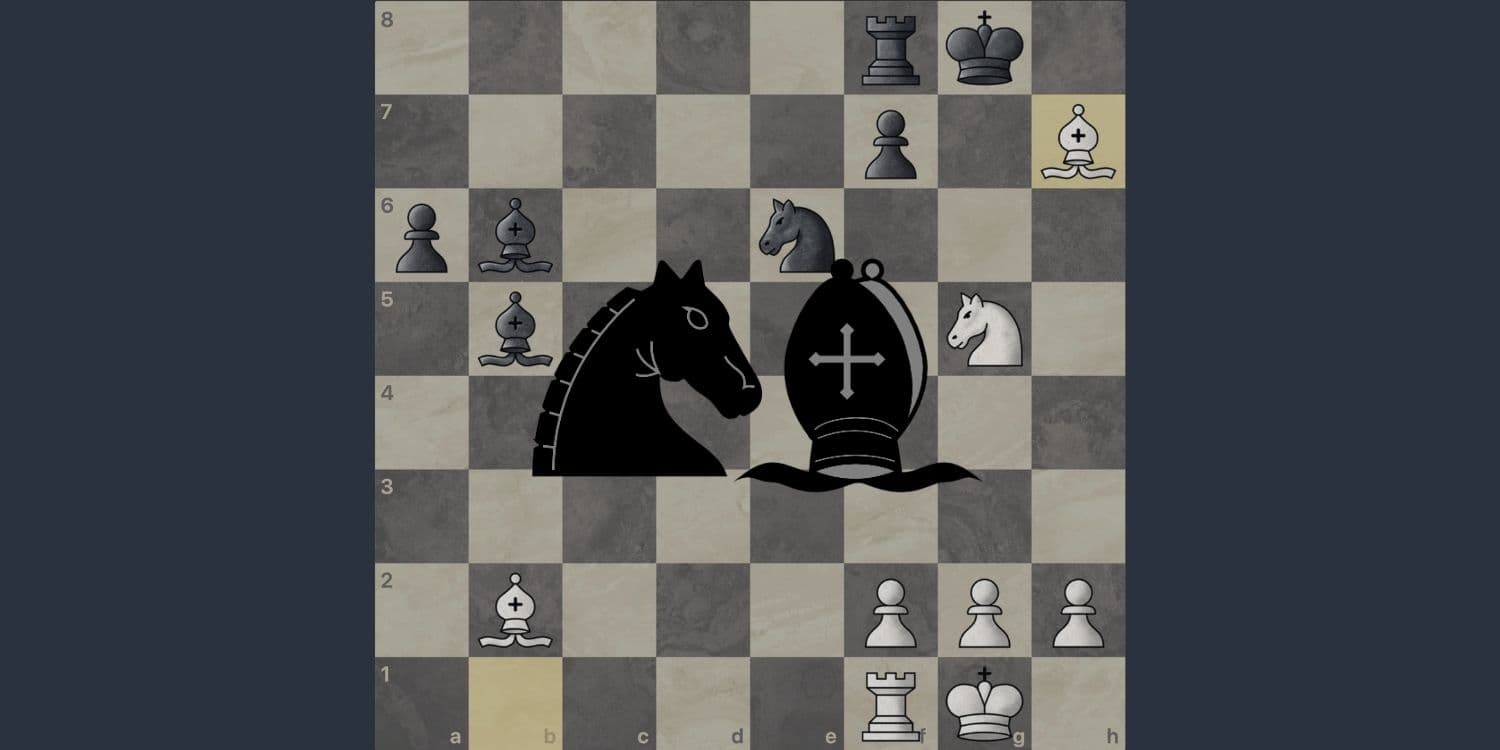Checkmate patterns in chess are one of the most important parts of the game to learn, especially for beginner players. You can play the perfect chess opening and follow all the middlegame principles to a tee, but if you can’t checkmate your opponent, it’s all for not.
As a beginner, learning a popper opening strategy and basic checkmating patterns are two of the most important aspects of chess to learn first. How to start the game and how to finish the game. Get a solid start and finish down first, then fill in the gaps in between the game.
In this post, we cover numerous checkmating patterns that exist. Do you have to learn all of them? Not at first, no. But learning a couple will make your games much easier.
Before I sat down to learn popper ways to checkmate an opponent, I was running into a lot of stalemates. As you might know, stalemates are incredibly frustrating, especially when you have a major surplus of material compared to your opponents.
Anastasia’s Mate

Anastasia’a Mate is a checkmating pattern with a Rook and a Knight. Knight forks are incredibly powerful for forcing your opponents King to move a square and possible capture another piece that is forked with the King.
With this mate, you force the King to move into a corner after the opponent castles. When the King is in check by a knight after the King is castled, the King usually only has one square to move to, which is the corner. If the pawn in front of the King isn’t there anymore, a Rook can move to that open file resulting in checkmate.
For more information, you can read the full guide on Anastasia’s mate.
Back Rank Mate

As a beginner, the Back Rank Mate will be very familiar to you, especially if you made this mistake over and over like I did when I started playing. It still happens to me even after playing nearly 1000 games.
This mate occurs after castling the King. If the Rook next to the King moves away from the 1 or 8 file also without moving any of the three pawns in front of the King. The King can be checkmated with a Rook or Queen moving to the 1 or 8 file. Unless the opponent has a piece that can either move next to the King or capture the Rook or Queen that put the King in check, it’s game over.
For more information, visit the guide on how to do the Back Rank Mate.
Blackburne’s Mate

Blackburne’s Mate is a mating pattern given with two bishops and a knight. This checkmate occurs when the opponent is castled and only one pawn is left of the three in front of the King and Rook. In this case, the remaining pawn would be in front of the Rook.
For more information, visit the guide on how to do the Blackburne’s Mate.
Boden’s Mate

Having both bishops working together on the right squares can be one of the most powerful strategies against your opponent.
Boden’s Mate is a checkmating pattern involving two bishops. To achieve this position with your bishops, it’s common to sacrifice other material to achieve positioning with your bishops.
A basic example of this mate is shown below.
For more information, visit the guide on how to do Boden’s Mate.
Damiano’s Mate

Damiano’s Mate is achieved involving a the combination of a Pawn or Bishop with a Queen. This checkmate was first discussed in a book written by Damiano all the back in 1512.
For more information, visit the guide on how to perform Damiano’s Mate.
Greco’s Mate

Greco’s Mate is a checkmating pattern involving the pressure on the usual f7 and h7 squares. It typically involves a Knight, Bishop, and Queen.
For more information, visit the guide on how to perform Greco’s mate.
Legal’s Mate

Legal’s Mate is a checkmating pattern involving two Knights and Bishop. It’s achieved typically in openings when your opponents Bishop is undefended.
For more information, visit the guide on how to perform Legal’s mate.
Morphy’s Mate

Named after the great Paul Morphy, Morphy’s Mate is a checkmate pattern given with a Rook and Bishop. It’s achieved typically in openings when your opponents Bishop is undefended.
For more information, visit the guide on how to perform Morphy’s mate.
Pillsbury’s Mate

Pillsbury’s Mate is a variation of Morphy’s Mate. This checkmate pattern is done with a Rook and a Bishop as well, only the checkmate is done with a Rook instead of a Bishop.
For more information, visit the guide on how to perform Pillsbury’s mate.
Reti’s Mate

Reti’s Mate is a checkmating pattern involving a Bishop and a Rook. This is one of the more uncommon mates you’ll see, but when it happens, it’s pure art. It’s achieved when the enemy King is being blocked by many of it’s own pieces.
For more information, visit the guide on how to perform Reti’s mate.
Smothered Mate

The Smothered Mate is a checkmate pattern that is typically achieved by literally smothering your opponents King in a corner of the board and using a Knight to end the game.
For more information, visit the guide on how to perform Smothered mate.
Fool’s Mate

Fool’s Mate is a checkmating pattern that all beginner Chess players deal with as this strategy typically occurs only at lower ratings below 1000. It’s also the fastest checkmate pattern in the game of Chess.
For more information, visit the guide on how to perform Fool’s mate.
Scholar’s Mate

Also known as the four-move checkmate, the Scholars Mate is a fun and quick way to start and finish a game with a beginner chess play. Something fun to do at parties or family gatherings with that cousin you don’t particularly care for,
This was also the first checkmate strategy that Beth Harmon was taught in the Netflix show, The Queens Gambit.
For more information, visit the guide on how to perform Scholar’s mate.
Ladder Mate

A Ladder Mate is a checkmate pattern involving two Rooks, or one Rook and a Queen, or two Queens. It’s one of the most common mates you’ll see in games. It’s a guaranteed way to give checkmate since the Rooks and Queen cover entire ranks so the King is easily trapped.
For more information, visit the guide on how to perform Ladder Mate.
Arabian Mate

Arabian Checkmate is the oldest checkmating pattern in the game of chess. It’s so old, it’s been seen in ancient Arabic manuscripts.
For more information, visit the guide on how to perform Arabian mate.
Frequently Asked Questions
How many Checkmates are there?
There are at least 35 different checkmate patterns. There is no definite number because there are mate patterns that have been forgotten or simply don’t have an established name assigned to them.
What is the fastest checkmate in chess?
The fastest checkmate in Chess is the Fool’s Mate, which is a two move checkmate, followed by the Scholar’s Mate.
Conclusion
There are dozens of different checkmate patterns used in the game of Chess. The more you learn and practice, the more strategies you’ll have at your disposal to win games.
I hope this guide on chess checkmate patterns helped you. If you liked this post, you might also be interested in reading other Chess guides like the guide on Chess Pieces or the guide on Chess Openings.
Be sure to bookmark this page for quicker access for when you need to reference it again.


